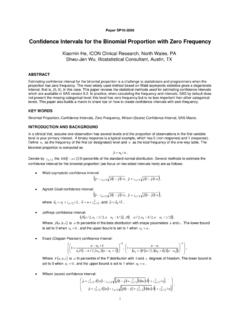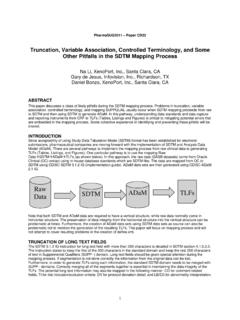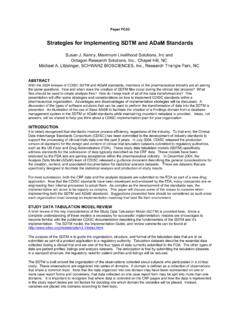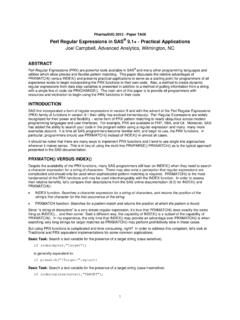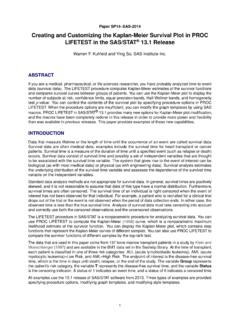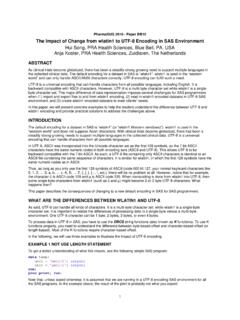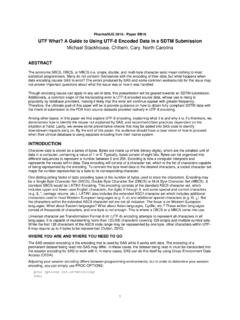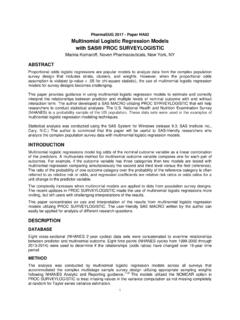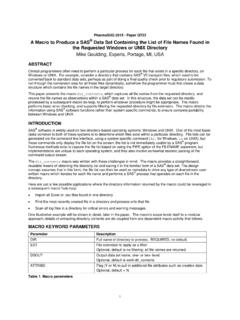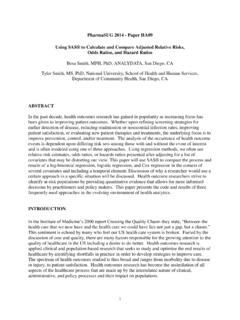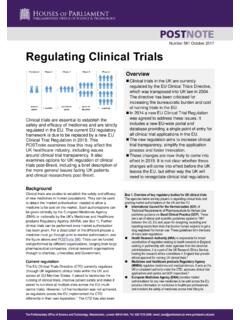Transcription of SDTM Trial Summary Domain: Putting Together the …
1 1 PharmaSUG 2016 - Paper DS11 SDTM Trial Summary Domain: Putting Together the TS Puzzle Kristin Kelly, Accenture Accelerated R&D Services, Berwyn, PA Jerry Salyers, Accenture Accelerated R&D Services, Berwyn, PA Fred Wood, Accenture Accelerated R&D Services, Berwyn, PA ABSTRACT The SDTM Trial Summary (TS) domain was updated with new variables and implementation strategies with the publication of the SDTM This was an attempt to make the domain more useful to reviewers and to be machine readable to facilitate data warehousing. The FDA has recently considered TS as being essential to include in a study submission. They have developed tools that check that the TS domain is populated according to the guidance in the SDTMIG and the FDA s Study Data Technical Conformance Guide (TCG). Despite the advice for implementation, constructing an informative and complete TS domain can be challenging for sponsors in terms of interpreting the guidance and using the correct controlled terminologies.
2 This paper will discuss some of the challenges associated with populating specific TS parameters, and provide some solutions for addressing these challenges. INTRODUCTION The SDTM Trial Design domains represent the plan for what will be done to subjects, and what data will be collected about them in the course of a clinical Trial , to address the Trial 's objectives. The Trial Design domains consist of the following: Trial Arms (TA), Trial Disease Assessments (TD), Trial Elements (TE), Trial Inclusion/Exclusion (TI), Trial Summary (TS), and Trial Visits (TV). According to the SDTM Implementation Guide (SDTMIG) , the standard Trial Design Datasets will allow reviewers to: clearly and quickly grasp the design of a clinical Trial compare the designs of different trials search a data warehouse for clinical trials with certain features compare planned and actual treatments and visits for subjects in a clinical Trial .
3 For these reasons, it is important that the Trial -level domains reflect the study design as accurately as possible. Although each of the Trial design domains provide a reviewer with important planned aspects of a clinical Trial in dataset format, the focus of this paper will be on the Trial Summary (TS) domain. The FDA has recently developed their own tools that run automated checks on the SDTM data when it is received as part of a submission, and before it is passed to a reviewer. This is done in order to identify data conformance issues earlier in an effort to save time downstream in the review process. The FDA has published business and conformance rules based on the SDTM standard and FDA data requirements. There is one domain, TS, that has become increasingly useful to FDA because it provides a high-level overview of the study without having to go too deep into the data or refer to the protocol.
4 There are several rules published by FDA that pertain to the TS domain that check the adherence to their expectations of the content of this dataset. With the publication of SDTM , several new variables were added to the TS domain that increase its usefulness in terms of machine readability and data warehousing. Because of these reasons, it is important that the TS domain be constructed properly. This paper will discuss the TS domain as a whole and also focus on some of the challenges encountered during development. TS BASICS THE PUZZLE OUTLINE The Trial Summary (TS) domain is a Trial -level dataset that allows for the submission of a high-level view of a study in a structured format. Each record contains the value of a parameter or characteristic of the Trial . It is used to record basic information about the study such as Trial phase, protocol title, and Trial objectives. It contains both planned and actual aspects of the Trial , such as the number of subjects, and study start/end dates.
5 The TS domain as a whole can be thought of as a jigsaw puzzle made up of interlocking pieces that need to be put Together in just the right way to make a complete picture. Typically, when working on a jigsaw puzzle, the first thing one might do is pick out the pieces with the flat edges that would make up the borders, or outline, of the puzzle. In the case of TS, these outline pieces could be compared to the variables that provide the structure for the dataset. Beginning in SDTMIG , several new variables were added to TS in an effort to make the submission of a SDTM Trial Summary Domain: Putting Together the TS Puzzle, continued 2 minimum set of parameters consistent across sponsors. These variables include TSVALNF, TSVALCD, TSVCDREF, and TSVCDVER. When specific parameter values cannot be provided, a new variable is used to submit reasons why it is missing (TSVALNF). These new variables can also be populated with reference to terminology used to populate TSVAL and the version used (TSVCDREF and TSVCDVER).
6 Because TS has become more standardized across studies, this has facilitated machine readability and storage. Since TS is not a general-observation-class domain, there is a finite set of variables allowed, and no other variables can be added to the domain. The variables are listed in Table 1 below and will be referenced throughout the sections of this paper. Please refer to the SDTM and later versions for more information. Variable Name Variable Label Type Controlled Terms, Codelist or Format Role CDISC Notes Core STUDYID Study Identifier Char Identifier Unique identifier for a study. Req DOMAIN Domain Abbreviation Char (DOMAIN) Identifier Two-character abbreviation for the domain. Req TSSEQ Sequence Number Num Identifier Sequence number given to ensure uniqueness within a dataset. Allows inclusion of multiple records for the same TSPARMCD, and can be used to join related records.
7 Req TSGRPID Group ID Char Identifier Used to tie Together a group of related records Perm TSPARMCD Trial Summary Parameter Short Name Char TSPARMCD Topic TSPARMCD (the companion to TSPARM) is limited to 8 characters and does not have special character restrictions. These values should be short for ease of use in programming, but it is not expected that TSPARMCD will need to serve as variable names. Examples: AGEMIN, AGEMAX Req TSPARM Trial Summary Parameter Char TSPARM Synonym Qualifier Term for the Trial Summary Parameter. The value in TSPARM cannot be longer than 40 characters. Examples Planned Minimum Age of Subjects, Planned Maximum Age of Subjects Req TSVAL Parameter Value Char Result Qualifier Value of TSPARM. Example: ASTHMA when TSPARM value is Trial Indication . TSVAL can only be null when TSVALNF is populated. Text over 200 characters can be added to additional columns TSVAL1-TSVALn.
8 Exp TSVALNF Parameter Null Flavor Char NULLFLAVOR Result Qualifier Null flavor for the value of TSPARM, to be populated if and only if TSVAL is null. Perm TSVALCD Parameter Value Code Char Result Qualifier This is the code of the term in TSVAL. For example; 6CW7F3G59X is the code for Gabapentin, C49488 is the code for Y. The length of this variable can be longer than 8 to accommodate the length of the external terminology. Exp SDTM Trial Summary Domain: Putting Together the TS Puzzle, continued 3 Variable Name Variable Label Type Controlled Terms, Codelist or Format Role CDISC Notes Core TSVCDREF Name of the Reference Terminology Char Result Qualifier The name of the Reference Terminology from which TSVALCD is taken. For example; CDISC, SNOMED, ISO 8601. Exp TSVCDVER Version of the Reference Terminology Char Result Qualifier The version number of the Reference Terminology, if applicable.
9 Exp Table 1: Trial Summary Variable Structure from the SDTMIG1 Trial Summary PARAMETERS (TSPARMCD/TSPARM) THE INTERIOR PUZZLE PIECES Within the variable structure of the TS puzzle, are the interior pieces or parameters ( , the data) that must be fit Together to provide a complete picture of a study. In order to make TS useful, a minimum number of Trial Summary parameters should be provided as shown below in Table 2. Most of the parameters come from , and the controlled terminology shown below is aligned with that Definitions of the parameters and controlled terminology values for TSPARMCD, TSPARM, and TSVAL (for CDISC defined codelists) are maintained by the National Cancer Institute's Enterprise Vocabulary Services (NCI EVS)6. The TSPARMCD codelist is extensible, meaning more values can be added as needed to describe the Trial . The column titled Inclusion in TS in Table 2 indicates whether the parameter should be included in the dataset.
10 If a parameter is listed as Required , the record should be included in the TS domain and either TSVAL or TSVALNF must be populated. In cases where a parameter is Conditionally Required or If Applicable , the presence and population depend on the study design. For example, if subjects are planned to take a protocol-specified treatment in combination with the investigational drug (ADDON (Added on to Existing Treatments) = Y ), then a record for TSPARMCD = CURTRT should be included. If the condition does not apply for a particular study and TSVAL cannot be populated, the corresponding TSPARMCD record need not be included. Please refer to the SDTMIG for specific conditions per parameter for those that are Conditionally Required . Extensible Addition parameters are present in the NCI TSPARMCD codelist and can be added as needed, depending on the protocol and any other information the sponsor wishes to add to the TS domain.
